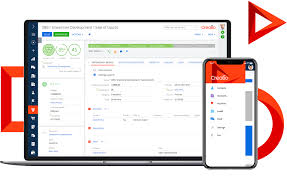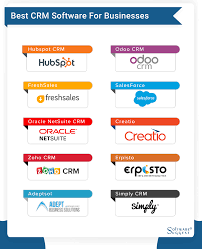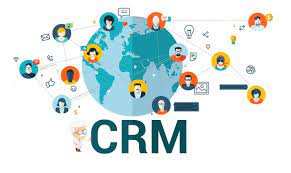Discover the Top CRM Software Solutions for Effective Customer Relationship Management
Top CRM Software for Effective Customer Relationship Management
Customer Relationship Management (CRM) software is essential for businesses looking to streamline their interactions with customers, improve customer satisfaction, and boost sales. With a plethora of CRM solutions available in the market, choosing the right one can be a daunting task. To help you make an informed decision, we have compiled a list of some of the top CRM software options:
Salesforce
Salesforce is one of the most popular CRM platforms used by businesses of all sizes. It offers a wide range of features including lead management, sales forecasting, customer service automation, and marketing automation. With its cloud-based system, Salesforce provides real-time access to customer data from anywhere.
HubSpot CRM
HubSpot CRM is known for its user-friendly interface and robust set of tools for managing contacts, deals, and tasks. It also offers email tracking, live chat integration, and reporting features to help businesses streamline their sales and marketing processes.
Zoho CRM
Zoho CRM is a comprehensive solution that caters to businesses across various industries. It offers modules for sales automation, marketing automation, customer support, and analytics. Zoho CRM also provides integration with other Zoho applications for seamless workflow management.
Microsoft Dynamics 365
Microsoft Dynamics 365 combines CRM and Enterprise Resource Planning (ERP) capabilities in a single platform. It offers features such as sales automation, customer service management, field service management, and project service automation. With its integration with Microsoft Office 365, users can access customer data directly from familiar tools.
Pipedrive
Pipedrive is a popular choice for small to medium-sized businesses looking for an intuitive CRM solution. It focuses on visual pipeline management to help users track deals and activities effectively. Pipedrive also offers email integration and reporting features to enhance sales performance.
Choosing the right CRM software depends on your business requirements, budget constraints, and scalability needs. Evaluate each option based on your specific needs to find the best fit for your organisation’s customer relationship management strategy.
Top CRM Software: 6 Key Advantages for Boosting Business Efficiency and Customer Engagement
- Enhanced customer relationship management capabilities
- Improved sales tracking and forecasting
- Streamlined marketing automation processes
- Centralised customer data for easy access and analysis
- Increased efficiency in managing leads and contacts
- Customisable features to suit specific business needs
Top CRM Software: Navigating Challenges from Complexity to Cost
- Steep learning curve for complex CRM systems like Salesforce
- High cost of subscription and additional features in premium CRM software
- Integration issues with existing software and systems may arise
- Customisation options can be limited in certain CRM platforms
- Data security concerns due to storing sensitive customer information online
Enhanced customer relationship management capabilities
One of the key advantages of top CRM software is its enhanced customer relationship management capabilities. By leveraging advanced features such as lead tracking, customer segmentation, personalised communication tools, and automated workflows, businesses can effectively nurture and strengthen their relationships with customers. This proactive approach enables companies to provide tailored solutions, anticipate customer needs, and deliver exceptional service, ultimately leading to increased customer satisfaction and loyalty. Top CRM software empowers organisations to build long-lasting relationships with their customers by centralising data, streamlining processes, and facilitating meaningful interactions at every touchpoint.
Improved sales tracking and forecasting
One significant advantage of top CRM software is the enhanced sales tracking and forecasting capabilities it provides. By utilising CRM tools, businesses can effectively monitor sales activities, track customer interactions, and analyse data to gain valuable insights into their sales pipeline. This enables organisations to make informed decisions based on real-time information, leading to more accurate sales forecasting and better strategic planning. With improved visibility into sales performance and trends, businesses can proactively identify opportunities, address challenges, and ultimately drive revenue growth.
Streamlined marketing automation processes
Streamlined marketing automation processes are a key benefit of top CRM software solutions. By automating marketing tasks such as email campaigns, lead nurturing, and customer segmentation, businesses can save time and resources while ensuring consistent and targeted communication with their audience. This automation not only improves efficiency but also enables businesses to deliver personalised messages at the right time, leading to higher engagement and conversion rates. With streamlined marketing automation processes, businesses can achieve greater effectiveness in their marketing strategies and ultimately drive growth and revenue.
Centralised customer data for easy access and analysis
One of the key advantages of top CRM software is its ability to centralise customer data, providing businesses with easy access to a comprehensive view of their customers. By storing all relevant information in one place, such as contact details, purchase history, interactions, and preferences, companies can streamline their operations and improve efficiency. This centralised data also enables in-depth analysis and reporting, allowing businesses to gain valuable insights into customer behaviour, trends, and opportunities for personalised engagement. Ultimately, having a single source of truth for customer data empowers organisations to make informed decisions and deliver exceptional customer experiences.
Increased efficiency in managing leads and contacts
One of the key benefits of top CRM software is the increased efficiency it brings to managing leads and contacts. By centralising all customer information in one platform, businesses can easily track interactions, monitor sales pipelines, and nurture relationships with prospects. Automation features streamline lead management processes, such as assigning leads to sales representatives, sending follow-up emails, and scheduling reminders. This enhanced organisation and automation not only saves time but also ensures that no potential opportunity falls through the cracks, ultimately leading to improved conversion rates and stronger customer relationships.
Customisable features to suit specific business needs
One key advantage of top CRM software is its customisable features that can be tailored to suit specific business needs. This flexibility allows businesses to adapt the CRM system to align with their unique processes, workflows, and requirements. By customising features such as data fields, reporting tools, automation rules, and user interfaces, organisations can enhance efficiency, improve productivity, and achieve a more personalised approach to customer relationship management. Customisation empowers businesses to create a CRM solution that is truly bespoke and optimised for their individual goals and objectives.
Steep learning curve for complex CRM systems like Salesforce
One significant drawback of top CRM software, such as Salesforce, is the steep learning curve associated with complex systems. Salesforce, known for its extensive features and capabilities, can be challenging for users to navigate and master quickly. The intricate setup process, customisation options, and diverse functionalities may require substantial time and effort for users to become proficient in using the system efficiently. This steep learning curve can potentially hinder productivity and delay the realisation of the full benefits of the CRM software for businesses and their teams.
High cost of subscription and additional features in premium CRM software
One significant drawback of top CRM software is the high cost associated with subscriptions and additional premium features. While these CRM solutions offer a wide range of functionalities to enhance customer relationship management, the expense can be prohibitive for smaller businesses or startups with limited budgets. The subscription fees and charges for premium features can quickly add up, making it challenging for some organisations to justify the investment, especially if they are not able to fully utilise all the advanced capabilities offered by the software. This cost barrier may limit access to cutting-edge CRM tools and technologies for businesses operating on tighter financial constraints.
Integration issues with existing software and systems may arise
One significant drawback of top CRM software solutions is the potential for integration issues with existing software and systems. When implementing a new CRM system, businesses may encounter challenges in seamlessly integrating it with their current tools and databases. This can lead to data silos, duplication of efforts, and inefficiencies in workflow processes. Addressing these integration issues requires careful planning, coordination, and sometimes additional resources, which can result in added complexity and costs for the organisation. Failure to overcome these integration hurdles may hinder the effectiveness of the CRM software and limit its ability to deliver the desired improvements in customer relationship management.
Customisation options can be limited in certain CRM platforms
In certain CRM platforms, a notable drawback is the limited customisation options available to users. While many CRM software solutions offer a range of features and functionalities out of the box, some businesses may find themselves constrained by the lack of flexibility in tailoring the system to meet their specific needs. This limitation can hinder organisations that require highly customised workflows, data fields, or reporting structures to align with their unique business processes. As a result, businesses seeking extensive customisation capabilities may need to explore alternative CRM platforms that offer more flexibility in adapting to their individual requirements.
Data security concerns due to storing sensitive customer information online
One significant drawback of using top CRM software is the data security concerns that arise from storing sensitive customer information online. With the increasing prevalence of cyber threats and data breaches, businesses face the risk of exposing confidential customer data to potential security vulnerabilities. Storing personal details, contact information, purchase history, and other sensitive data on cloud-based CRM platforms can make businesses susceptible to hacking attempts and unauthorized access. This raises valid concerns about data privacy and compliance with regulations such as GDPR. Organisations must implement robust security measures and encryption protocols to mitigate the risks associated with storing sensitive customer information online when utilising CRM software.









